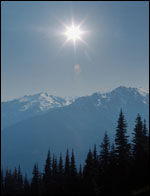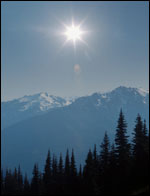
Raise a toast to solar radiation.
The director of the Zurich-based World Radiation Monitoring Center, the organization that measures the amount of solar radiation hitting the ground around the globe, has a strange talent. Give Atsumu Ohmura a glass of white wine and tell him only its vintage, and he’ll swish a mouthful and — without referring to legs, bouquets, or mango backgrounds — announce where the grapes were grown.
His trick? The sweetness of white wine grapes is a function of solar radiation. The more sun a grape plant’s leaves absorb, the more sugar the plant produces and the more sweetness it infuses into the fruit. So if you pay really close attention to the global meteorological records, and in particular the geographic distribution of solar radiation, then when you sense a wine’s sweetness, you can infer its region of origin. “I really trained my tongue for that!” Ohmura exclaims.
Now, maybe you don’t believe him. You might think that the director of the World Radiation Monitoring Center has spent a little too much time baking in the sun. Take it easy, Ohmura; go sit under a willow tree for a while, and lay off the Fetzer, okay? But perhaps you should reconsider. After all, this is the guy who compiled virtually every meteorological record of solar radiation since monitoring began, and ended up discovering global dimming.
Global dimming? Does that have something to do with decreasing IQ scores and the proliferation of reality TV? Not quite, but if you missed the story, you would not be the only one. Until Ohmura poked his nose into the radiation record, nobody had noticed that between 1958 and 1988, a whopping 10 percent of solar radiation had disappeared.
Ohmura hadn’t set out to find missing sunlight. All he wanted, he says, was “something to do” in the evenings, a way of relaxing after a hard day of theoretical calculations at the Swiss Federal Institute of Technology, where he was an assistant geology professor specializing in radiation. So, logically, he decided to review the records of the world’s weather services. And what began as a hobby ended up becoming an epic traverse through the history of solar radiation.

No, they’re not flying saucers; they’re
pyranometers.
While Ohmura reviewed national meteorological records, his students picked through 50 journals a week, copying and pasting solar radiation measurements into a database until they had observations from 1,600 locations around the world, including the very oldest continuous measurement, recorded by the Swedish professor Anders Angstrom in 1922. (Angstrom is famous for crawling up onto the roof of the University of Stockholm to set up his novel pyranometer, the first device to accurately measure direct and indirect solar radiation, thus initiating the science that would lead Ohmura to the missing sunlight.) Never before had anyone drawn such a thorough picture of worldwide solar radiation levels, so Ohmura had no idea what the data would show until the results were in front of him.
At first it was hard for him to believe. “It was rather incredible,” Ohmura says of the 10 percent decline in solar radiation. However, his data were extensive, and to him, incontrovertible. But when he told an audience at the 1988 International Radiation Symposium in Lille, France, about the missing chunk of energy? “Oh, they didn’t believe it at all,” he says.
Critics charged that the numbers must be wrong. They were too big to be true. Moreover, the idea of a much darker planet didn’t fit into conventional climate models, which predicted a much brighter planet. Besides, what phenomenon could account for Ohmura’s findings? In the face of these criticisms, the theory went largely unnoticed for an entire decade.
Ohmura isn’t bitter, though. He simply chuckles and concludes that people don’t like change. Sometimes, he says, revolutionary ideas must endure a period of negligence: “You know, Galileo was almost killed because he supported Copernicus’ idea that the Earth was rotating around the sun, not the other way around.”
Dimming’s Future Bright
For global dimming, that period of negligence is now over. Shabtai Cohen and Gerald Stanhill are among the growing flock of scientists who, since Ohmura’s discovery, have conducted research on the dark matter. In 2001, these Israeli researchers concluded that between 1958 and 1992, sun worshipers got hit with a nearly 10 percent radiation tax — virtually the same conclusion that Ohmura had reached in 1988, but that the scientific community rejected.
Then, in 2003, Graham Farquhar and Michael Roderick, climatologists at the Australian National University in Canberra, discovered corroborating evidence in the global evaporation record. They announced that declining evaporation rates could be explained by declining levels of solar radiation. And finally, this past May, a group of scientists, including Cohen and Roderick, held a special session at the meeting of four geophysical unions in Montreal to proselytize about the disturbing phenomenon.
“It’s difficult to get people to accept this,” Cohen says. The goal of the conference was to change that. Hopefully, he says, the critics have finally discarded their doubts about the data and returned to their labs to look deeper into global dimming’s causes.

See how dim it is?
The going explanation for the loss of sunlight is that particulate pollution such as soot plugs up clouds, so that “when it’s cloudy, it’s darker than before,” Cohen says. Ulrike Lohmann, a climate modeler at Dalhousie University’s Physics and Atmospheric Sciences Department in Halifax, Nova Scotia, agrees with that assessment. She and colleague Beate Liepert of Columbia University published a paper in the March 2004 edition of the journal Geophysical Research Letters outlining the theory.
Lohmann explains that clouds change as we emit more particles into the atmosphere. Clouds are made of cloud droplets, which form by latching onto tiny particles called condensation nuclei. These occur naturally in the atmosphere, but by emitting more particulate pollution into the atmosphere, humans help make even more condensation nuclei. The result: Instead of fewer, larger water droplets forming, many, smaller water droplets form. In effect, this is like the difference between two sieves, one coarse and the other fine. Like a coarse sieve, the cloud with fewer, larger particles lets more solar radiation through to the ground, whereas like the fine sieve, the cloud with lots of very small particles lets less sunlight pass through. The result is darker days.
So should you throw out those costly Ray-Bans and sell that beach house in Bermuda?
Well, hold on a moment, Ohmura says. He’s getting ready to unload his next big idea, the one that explains the global warming paradox of the 1950s, ’60s, and ’70s. For some time, scientists have wondered why, during the ’60s and ’70s, temperatures remained relatively stable, or even got colder, while at the same time there were plenty of greenhouse gases to crank up the thermostat.
To illustrate the point, Ohmura cites the average annual melt rates for each of the last four decades for 40 glaciers around the world. He rattles them off: in the 1960s, the glaciers retreated by 200 mm per year; 1970s, 180mm per year; 1980s, 260mm per year; and the whopper, 1990s, 480mm per year. “The negativeness is amazing,” he whispers. These figures demonstrate what he calls the double punch.
Ohmura believes that during the ’60s and ’70s, global dimming, caused by particulate pollution, buffered the climate against global warming, caused by greenhouse gases. As the increasing amounts of gases warmed the Earth, the increasing amounts of particulate pollution reduced the sunlight that reached its surface, thereby cooling the planet. In other words, one form of pollution counteracted the other. Hence the lower melt rates and stable temperatures of the 1970s.
But then, scientists realized that particulate pollution was almost entirely responsible for deaths related to air pollution — pollution that still causes a staggering 135,000 premature deaths in the United States every year. (That’s 6 percent of all deaths from any cause.) That may seem like a lot, but consider that by 1990, the U.S. EPA found that if Congress hadn’t adopted the Clean Air Act in 1970 and amendments to the act in 1977, particulate matter would have prematurely caused the deaths of 184,000 more Americans per year. Clearly, this type of pollution was (and is) a big problem. So, wisely, the industrialized world began cleaning up its act, curtailing emissions of soot and smoke.
So what about that buffer? As emissions of deadly particulate matter decreased, so did their cooling power. Clouds let the sun shine through and — behold! — the greenhouse effect’s disguise was cast aside. “Because of this double punch [of more solar radiation and more greenhouse gases], the global temperature increased enormously,” Ohmura concludes. Preliminary results of his, based on radiation records from 1992 to present, support this theory. Key monitoring stations show a resurgence of radiation levels during the 1990s — not to pre-1958 levels, but enough to expose the true warming potential of greenhouse gases.
The implication is that the power of both particulate matter and greenhouse gases on the climate have been underestimated. Traditional global climate models will have to be revised, and although the interactions between climatological components is complex and uncertain, revised models and Ohmura’s results will undoubtedly raise challenging questions for the public and for policy makers. For instance, will further reductions in particulate pollution, necessary to alleviate serious, deadly, and widespread respiratory illnesses, mean even more global warming? And if so, do even progressive policies, including the Kyoto Protocol, underestimate the potential damage of climate change?
Whether or not the double-punch theory holds up to a round of scientific scrutiny is impossible to predict, but for now, Ohmura hopes that recalcitrant attitudes will change. “Authority in the natural science is, after all, nature. So unless one observes nature very carefully, there’s no anchor in our knowledge. Whether our abstract idea is correct or wrong, we must ask nature, and that is only possible by observation.”
Ohmura believes that nature has spoken. But will people listen?


